Afriboria
Fastplay card driven colonial wargame
<< Back to overview | 1 | 2 | 3
Designer's notes
This is another set in my card driven wargame rules "Command by Colour", and although still loosely inspired by the Battle Cry & Memoir '44 games by Richard Borg, the game no longer has a battlefield divided in 3 sections, because spreading a (smaller) imperial force across the battlefield would not always be realistic or playable, since in most colonial battles a smaller well armed imperial army faces hordes of natives. The left-centre-right wing Battle Cry/Memoir '44 principle has here been replaced by colour-coding the units red, green and blue (activated by cards of the same colour) thus enabling the imperialist player to concentrate his units anywhere on the battlefield if he wishes so. Also, compared to ACW or WWII, there was a much bigger difference in quality of weapons used by imperialists and natives. Therefore the symbols on the dice are no longer representing the targets but rather the type of ammo/weapon used, whereby the more modern weapons have a better chance of scoring hits than outdated ones (see rules).
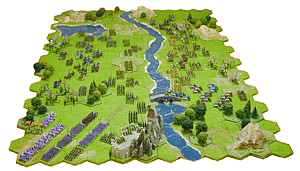
Since many colonial games are played in "Darkest Africa", an (optional) set of "event cards" is added in order to spice up the "adventure" type games. When using the fast play variant, games with 20-30 native units (and about half of that number of imperial forces) can be concluded in 90-120 minutes (ideal for a clubnight). In order to have a balanced game, the number of victory points to be scored by imperialist armies should be around 1.5 times higher than for native forces.
When viewing the rules, please bear in mind that (after reading them thoroughly and playing a few games) the order sheet will normally suffice to play the game.
Learn to play
Typically for this period, you would have a smaller (A & B class) imperial force facing a larger (mainly C, perhaps some B class) native force. For a tryout, I would suggest a ratio of 2 native units for every imperial unit; the same for officers/tribal overlords & NCO's/tribal chieftains. This enables the native player to create more "companies" & "platoons" than the imperial player, which he needs to bring his forces to bear against the superior firepower of the imperialists (certainly when those remain stationary & fire). However, once B & C class troops get into close combat, they have an extra die-symbol (crossed sabers) to score a hit and since "double fire" of A class infantry does not count in close combat, the imperialists must try to kill as many figs in a native unit as possible from a distance (as in reality) in order to activate the "flags" (forced retreat) or to eliminate the native unit.
Victory points: taking into account the above, I would suggest 3 (natives) and 5 (imperialists) victory points as winning score for the first couple of games. It makes the game more interesting when one of the native victory points is to be gained by destroying the imperialists' (ammo) supply (e.g. a waggon; 1 point scored by taking the waggon and thus destroying it). This is certainly the case when the natives have some cavalry or camelry units to threaten with! This means that the natives only have to capture the waggon & eliminiate 2 imperial units to win the game... Thus the imperialist player cannot solely rely on his firepower and spread his units across the field through "wild charges" and go unpunished.
As in most card drive games, you start with a certain number of command cards in your possession. Normally, this number is mentioned in the scenario (and may differ for each side), but for a tryout I would suggest 4 cards for each player.
It is our experience that with multiple players on each side (and since the game is card driven), they tend to "team up" and automatically discuss the command cards at hand (and their tactics). One player can also assume command of all (or part) of the troops in one colour.
Remember: you're (probably) in the bush, so don't forget trees, elephant grass, hills & possibly a river in your terrain layout.
Rudi Geudensrudi.geudens@edpnet.be
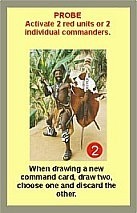
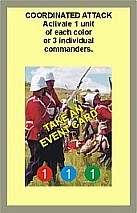
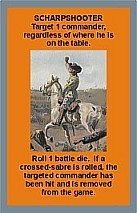
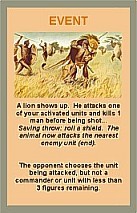
(Left to right): standard command card, standard command card connected to an event-card (optional), special command card, back of both standard & special command cards, event card & back of event cards. The cards in the pdf files are the right size for the clear plastic sleeves as sold for (collectable) card games in most games stores.
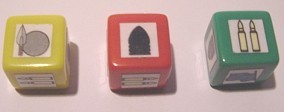
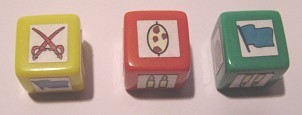
The special Afriboria dice made with blank dice & the stickers from the downloads. These can be replaced by normal dice if you wish so (see rules).
<< Back to overview | 1 | 2 | 3